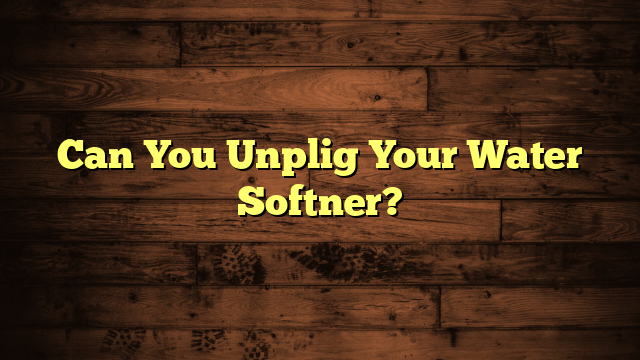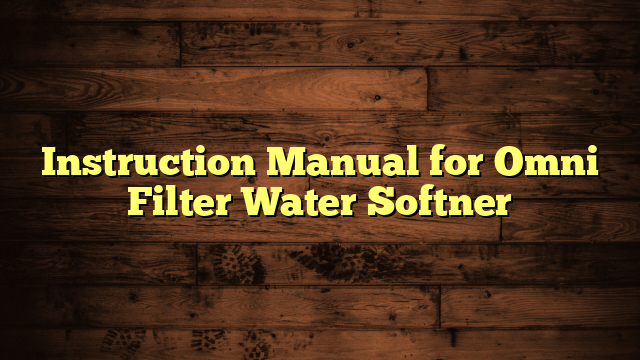Can I Install Water Softner System Outdoors?
When contemplating whether to install a water softener system outdoors, you'll want to weigh the benefits, assess the risks, and understand the local regulations. An outdoor installation can save space and simplify maintenance, but it also exposes your system to weather elements that could lead to damage. You might be wondering how to protect your investment and guarantee efficiency in various climates. Knowing the right steps to take can make a significant difference—so let's explore what you need to take into account before making that decision.
Key Takeaways
- Yes, water softener systems can be installed outdoors, but proper planning is essential to address weather exposure and accessibility challenges.
- Outdoor installation frees up indoor space and can enhance outdoor aesthetics with landscaping or enclosures.
- Ensure the installation area is well-drained and maintains a temperature range of 32°F to 100°F for optimal performance.
- Regular maintenance access is crucial, so allow at least 2-3 feet of clearance around the unit for easy servicing.
- Check local zoning laws and regulations to ensure compliance with safety standards and avoid potential fines.
Understanding Water Softener Systems
Water softener systems are vital for tackling hard water issues, which can affect everything from your plumbing to your skin. Understanding the different water softener types is important when evaluating a system for your home. The most common types include salt-based ion exchange systems, which replace hard minerals with sodium ions, and salt-free alternatives that condition water without removing minerals.
Each type has its own pros and cons, so it's important to assess your specific needs.
When it comes to installation methods, you'll find several options available. Many homeowners choose a DIY approach, especially for simpler systems that require basic plumbing skills. However, for more complex systems, hiring a professional might be the best route to guarantee everything's installed correctly.
You'll also want to take into account if you're placing the system indoors or outdoors, as this could impact the installation process.
Regardless of the method you choose, guaranteeing proper setup will help maximize the benefits of your water softener and improve your water quality. By understanding these systems, you can make an informed decision that suits your needs and lifestyle.
Benefits of Outdoor Installation
Installing your water softener system outdoors offers several key advantages that can enhance both performance and convenience.
First, outdoor installation optimizes space in your home, freeing up valuable interior areas for storage or living. You won't have to sacrifice room in your utility space or garage, making it easier to organize your home.
Another benefit is the potential for improved outdoor aesthetics. With the right setup, your water softener can blend seamlessly into your yard or garden area. You can use landscaping or decorative enclosures to keep unsightly equipment out of view, enhancing the overall look of your outdoor space.
Additionally, installing your system outside can help with maintenance. Since water softeners require periodic salt refills and other upkeep, having the unit outdoors makes these tasks more manageable without cluttering your living areas.
Plus, outdoor installations often benefit from better ventilation, reducing the risk of overheating or humidity-related issues.
Potential Risks and Challenges
When you install a water softener system outdoors, you face some potential risks and challenges that can impact its performance.
Weather exposure can lead to damage over time, while maintenance accessibility might become a hassle if you need to reach the system frequently.
Understanding these factors is essential for ensuring your system runs efficiently and lasts longer.
Weather Exposure Issues
Exposing a water softener system to the elements can lead to several potential risks and challenges. One major concern is the weather impact on the system's components.
Extreme temperatures, whether hot or cold, can affect the materials used in your softener. For instance, freezing temperatures can cause pipes to crack, while excessive heat may warp or damage plastic parts. These weather-related issues can greatly shorten your installation longevity, leading to costly repairs or replacements.
Additionally, rain and humidity can lead to corrosion, especially if the system isn't designed for outdoor use. Moisture can infiltrate electrical components, creating risks of malfunction or even electrical hazards.
UV exposure from sunlight can also degrade materials over time, resulting in premature failure.
Finally, it's crucial to reflect on dirt and debris, which can accumulate around the unit, potentially impacting its performance.
Maintenance Accessibility Challenges
Over time, maintaining an outdoor water softener system can present significant accessibility challenges. When you decide to install your system outside, you'll need to evaluate how easy it'll be to perform routine maintenance.
Here are a few potential accessibility issues you might face:
- Weather Conditions: Rain, snow, and extreme temperatures can make it difficult to access your system.
- Location: If your water softener is tucked away in a hard-to-reach spot, you'll struggle with maintenance frequency.
- Physical Barriers: Landscaping, fences, or even your home's structure can hinder your ability to perform necessary checks and repairs.
- Equipment: You may need specialized tools that aren't readily available or are cumbersome to use in an outdoor setting.
These challenges can lead to delays in maintenance and potential problems down the line.
Regular upkeep is essential for the longevity of your water softener, so it's important to contemplate these accessibility issues before deciding on an outdoor installation.
Temperature Considerations
How do temperature fluctuations impact the performance of your outdoor water softener system? When you place your water softener outdoors, temperature extremes can greatly affect its efficiency.
If you live in an area that experiences freezing temperatures, you need to be especially cautious. Water softeners contain water, and when the temperature drops, that water can freeze, potentially causing damage to the unit.
Additionally, extreme heat can lead to evaporation of the brine solution, which is vital for the softening process. If your system isn't properly insulated or shielded, it might struggle to maintain ideal performance during these temperature swings.
To guarantee your water softener operates efficiently throughout the year, consider insulating the unit or placing it in a temperature-controlled environment.
Even a simple cover can make a difference, protecting it from the harsh winter chill and summer heat. Remember, maintaining the right temperature is essential for the longevity and effectiveness of your system.
Protection From Environmental Elements
Your outdoor water softener system needs protection from environmental elements to guarantee it operates effectively. Without proper shielding, harsh conditions can lead to malfunctions or decreased performance. Here are four essential considerations for safeguarding your unit:
- UV Protection: Direct sunlight can degrade components over time. Use UV-resistant covers or enclosures to protect against harmful rays.
- Outdoor Insulation: Insulating your system helps maintain ideal temperatures, especially during cold months. Consider foam insulation or specialized wraps to keep your system safe from freezing.
- Wind Barriers: Strong winds can cause debris to hit your water softener, leading to damage. Erect barriers, like fences or shrubs, to deflect wind and shield your system.
- Drainage Solutions: Verify proper drainage around your softener. Heavy rain can lead to flooding, which can damage electrical components and reduce functionality.
Maintenance and Accessibility
When it comes to maintaining your outdoor water softener system, you'll want to reflect on how seasonal weather impacts its performance.
Regular access for maintenance is essential, so think about the space you have during installation.
Keeping these factors in mind will help guarantee your system runs smoothly year-round.
Seasonal Weather Considerations
Considering seasonal weather changes is essential for maintaining your outdoor water softener system. Different weather conditions can impact its performance and longevity. Here are some key considerations to keep in mind:
- Frost Protection: Make sure your system is insulated during colder months to prevent freezing. This may involve wrapping pipes or using heated cables.
- UV Shielding: Your system should be shielded from direct sunlight. Excessive UV exposure can damage various components, so a protective cover or housing is a must.
- Drainage Management: Heavy rainfall can affect the system's drainage. Ensure that your setup has proper drainage to prevent water from pooling around it.
- Temperature Fluctuations: Extreme temperature changes can affect how well your water softener operates. Consider installing it in a location that's shielded from sudden temperature swings.
Regular Maintenance Access
Accessing your outdoor water softener system for regular maintenance is essential to guarantee it runs efficiently year-round.
To keep your system in top shape, you'll need to adhere to a maintenance frequency that suits your specific water conditions and system type. This often means checking the salt levels, cleaning the brine tank, and inspecting the resin bed regularly.
However, you might face accessibility challenges when your system is located in a tight or hard-to-reach spot. If the setup is surrounded by plants, furniture, or other obstacles, it can make routine checks a hassle.
To combat this, consider planning your installation site carefully. Make certain there's enough room for you to move around comfortably, allowing for easy access to valves, tanks, and any other components you'll need to service.
Installation Space Requirements
Your water softener system's installation space is essential for guaranteeing both maintenance and accessibility.
Choosing the right installation area can greatly impact how easily you can perform routine checks and necessary repairs.
Here are four key space requirements to take into account:
- Clearance: Confirm there's at least 2-3 feet of clearance around the unit for easy access.
- Drainage: Your installation area should have a proper drainage system to handle any overflow or backwash.
- Temperature Control: Install your system in a space that stays between 32°F and 100°F to prevent freezing or overheating.
- Proximity to Water Supply: The closer your system is to your main water supply, the easier it'll be to install and maintain.
Local Regulations and Codes
Local regulations and codes play an essential role in determining how you can install and operate a water softener system outdoors. Before you start the installation process, it's vital to check your local zoning laws. These laws often dictate where you can place your system, guaranteeing it doesn't interfere with property lines or neighbors' rights.
You'll also need to navigate the permitting process. In many areas, installing a water softener system requires a permit to verify compliance with safety and environmental standards. This process can vary greatly from one municipality to another, so it's wise to contact your local government or water authority for guidance. They can provide you with specific requirements, including any necessary inspections.
Ignoring these regulations can lead to fines or even the requirement to remove your system, which can be a hassle. So, before you dig in and set up that outdoor system, take the time to research and understand the local codes.
This proactive approach not only saves you trouble but also helps guarantee that your investment in a water softener system is both legal and effective. Always prioritize compliance for a smoother installation experience!
Alternatives to Outdoor Installation
When reflecting on the installation of a water softener system, you might find that outdoor placement isn't the best option for your situation.
Fortunately, there are several indoor alternatives that can effectively meet your needs. Here are four options to take into account:
- Traditional Indoor Systems: These are designed to be installed in your basement, garage, or utility room, providing protection from the elements and ensuring optimal performance year-round.
- Portable Systems: If you need flexibility, portable systems can be a great choice. They allow you to treat water at different locations in your home, making them ideal for renters or those with limited space.
- Point-of-Use Systems: These smaller units can be installed at specific faucets or appliances, providing targeted softening where you need it most, without the need for a full-system installation.
- Salt-Free Systems: For an eco-friendly alternative, take into account salt-free systems that condition water without using salt. They can be installed indoors and are easier on your plumbing.
Frequently Asked Questions
Can I Install a Water Softener Near My Pool?
You can install a poolside water softener, but consider outdoor plumbing considerations. Make certain it's protected from elements and easily accessible for maintenance. Proper placement will enhance your pool experience and prolong the softener's lifespan.
Will Outdoor Installation Void My Warranty?
You'd think outdoor installation wouldn't affect warranty coverage, but it often does. Always check your installation guidelines first; you might find that placing it outside can lead to voiding your warranty. Don't risk it!
How Often Should I Check My Outdoor Water Softener?
You should check your outdoor water softener monthly to guarantee ideal water quality. Following a regular maintenance schedule helps prevent issues and prolongs the system's lifespan, keeping your water softener functioning effectively for years.
Can I Use a Solar-Powered Water Softener Outdoors?
Imagine harnessing solar efficiency for your water softener. You can indeed use a solar-powered water softener outdoors, but remember, regular outdoor maintenance is key to guarantee peak performance and longevity in varying weather conditions.
What Is the Best Location for Outdoor Installation?
For outdoor installation, choose a shaded area to protect the system from extreme temperatures. Follow best practices by ensuring proper drainage and accessibility for maintenance. Keep installation tips in mind to optimize performance and longevity.
Conclusion
In conclusion, installing a water softener system outdoors can be advantageous, but it does come with its own set of challenges. Did you know that nearly 85% of U.S. households have hard water? By taking proper precautions—like choosing a sheltered spot and ensuring insulation—you can protect your system from the elements. Regular maintenance is key to keeping everything running smoothly. So, if you're considering an outdoor installation, just remember to plan carefully and follow local guidelines.







